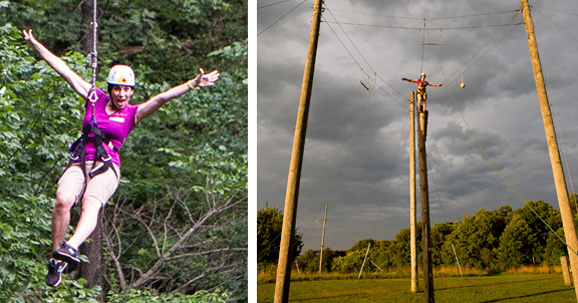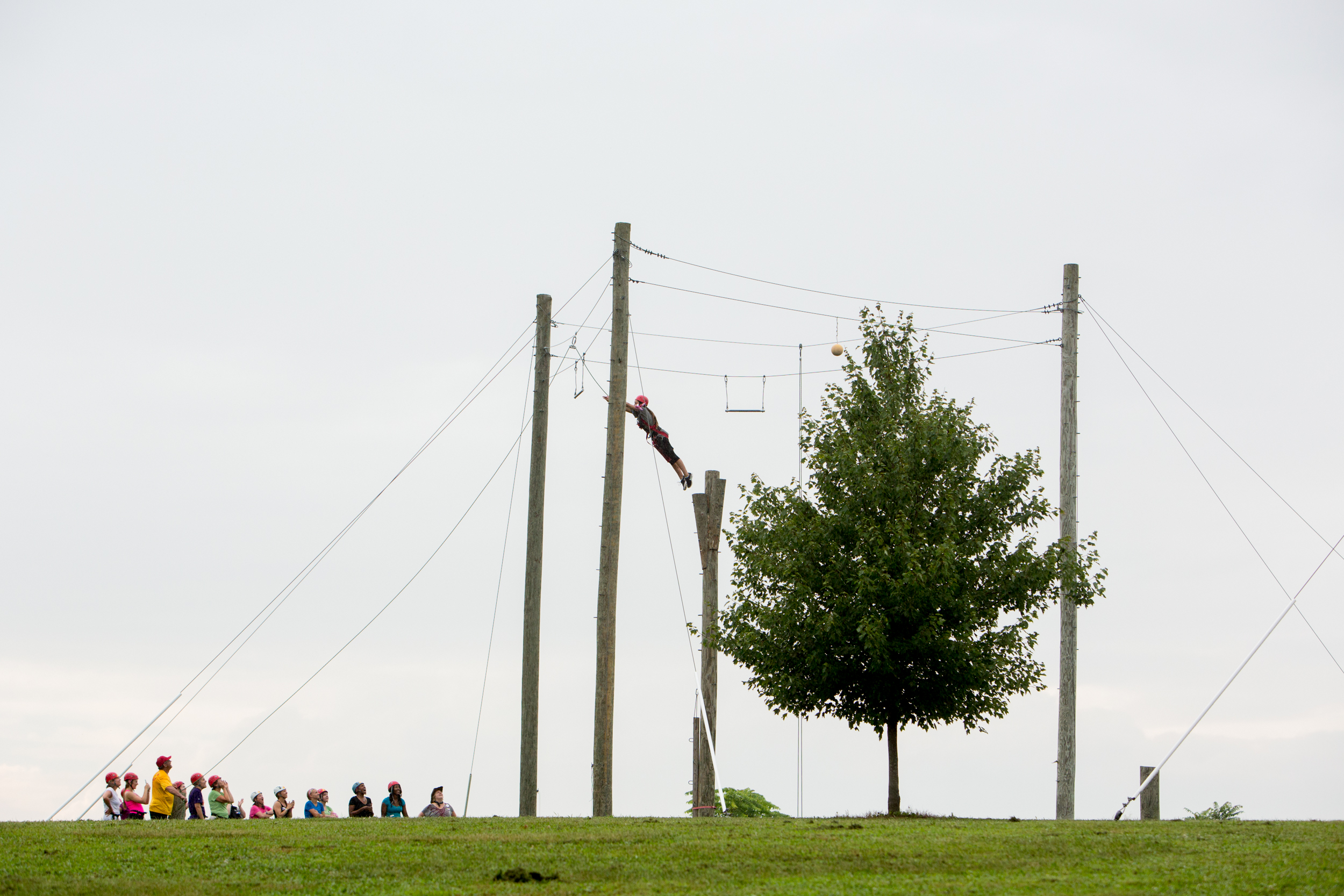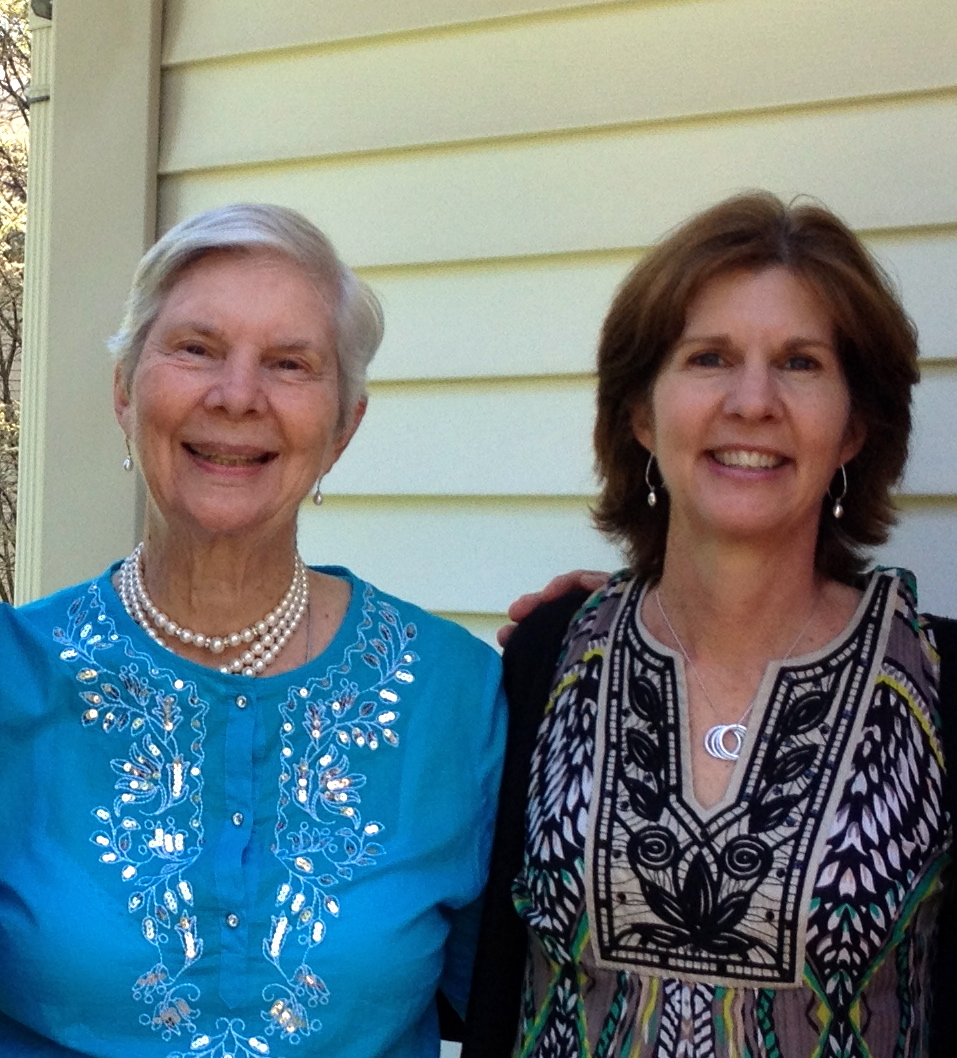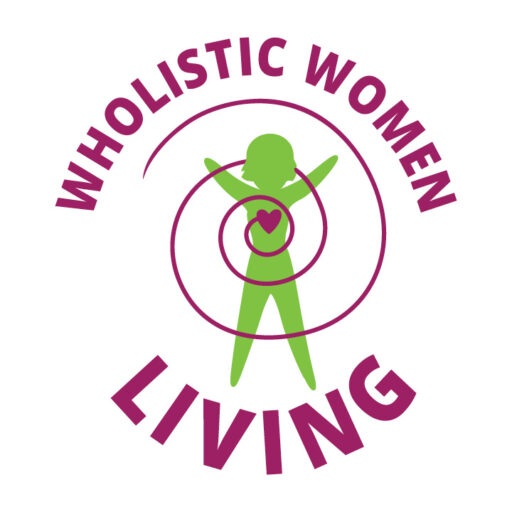
by Carol deLaski | Jul 30, 2014 | Business, Courage, Fear, Guest Blogging, Personal Development, Professional Development
We are happy to welcome Kim Dow, our fabulous Wholistic Woman Alliance Partner, graphic designer, and today’s guest blogger as she shares what she learned at the Be Courageous Retreat.
I have a healthy fear of heights. It’s cool, I’m not afraid to admit it!
But, recently, I set a goal for myself and conquered that fear. I joined our client, Wholistic Woman Retreats, for their annual “Be Courageous” event at Upward Enterprises, a zip lining and ropes challenge course in Buckeystown, MD.
Amidst the zipping and free-fall swing fun, lay the “Leap of Faith” (possibly mistaken as the Leap of Death…but whatever). A towering site where you climb up a single telephone pole, using just small hooks to brace your feet and cling to with your hands. Once you reach the top, you have to maneuver yourself around on a small plateau to face yourself outwards. Then, you jump off the top of the pole, aiming for a trapeze hanging in mid air. No biggie, right? WRONG!
Holy. Crap. Despite having done this challenge once several years ago (or maybe because of it), and knowing that I was safely harnessed in…my heart was still beating, my legs were still shaking and my brain was still screaming at me “Abort, Abort—We Are Up WAY Too High!” But, I kept my goal in mind and found the strength and inner will to keep climbing—to keep going for it and conquer the fear.
This experience is no different than what we face as entrepreneurs. Business owners face many fears—fear of failure. Fear of where your next job or payment will come from. Fear of change. Fear of not being able to pay your employees or yourself. Fear of not being good enough. Fear of the unknown. I think it’s safe to say that starting and owning your own business can, at times, be downright scary. But, you always have to try and overcome those fears—sometimes even embracing them—and keep moving forward to your end goal(s). To continuously push yourself and to keep moving forward, knowing those fears and the risks are just a part of the journey.
For me, back on that 20-something high (okay, so I don’t really know how high it was, but let me tell you when you’re at the top of it, it feels twice as high as it looks!) it wasn’t the jumping off part that was the scariest. It was the climb. Especially when I was almost at the very top…that was the hardest part. And isn’t that the same with our business as well? It’s the planning, the strategizing, all the hard work that leads us to that “top” (whatever point or end goal that may be for you). Once you’ve made that climb, it almost seems easy to take that final “Leap of Faith” and jump off!
And hey, it’s okay if you have to take a break on the way up—catch your breath, gather your thoughts, adjust your climbing strategy. But, just be sure to keep climbing, because it’s worth it!
Another important aspect of my Leap of Faith experience was the positive encouragement and cheering received from all those watching (and the fact that I, in turn got to cheer others on when my turn was over). The encouraging, supportive words truly made it easier to keep going! And I believe this is also a very important aspect of entrepreneurship. Surround yourself with supportive friends, family and colleagues—it definitely can make a huge difference, especially when you doubt yourself!
 A special thank you to Wholistic Women Retreats and the coaches who plan this amazing event each year. And another huge thanks to Clive Felgate and his amazing team at Upward Enterprises. I can’t wait for next year’s adventure!
A special thank you to Wholistic Women Retreats and the coaches who plan this amazing event each year. And another huge thanks to Clive Felgate and his amazing team at Upward Enterprises. I can’t wait for next year’s adventure!
Kim Dow is owner of Kalico Design, a creative and wholistic graphic design firm in Frederick, Md. You can learn more about Kim and her company by visiting www.kalicodesign.com
Thank you to Mary Kate McKenna Photography for great shots of this fun event!
Save

by Carol deLaski | Jul 21, 2014 | Courage, Guest Blogging, Personal Development, Professional Development
Last week’s Zip, Swing, and Leap event was an enlightening experience. The evening started with Carol recommending to each of the women to observe themselves and their experience, as that is the best way to learn from the activity. I was a floater coach, a supporter of the participants, ropes team, and the event. I learned not by actually doing the events, but by supporting and observing others.
Throughout the evening I witnessed the power of women deciding they CAN. That they are able, they will trust, they know they are supported, and they are scared to death and are going to do it anyway.
I spent most of my time that night at Leap of Faith. The Leap of Faith requires a full body harness that, once you jump, holds you at the back of your neck, like Peter Pan flying across the stage on Broadway. Once in the harness, you climb a telephone pole, turn around on the top, stand tall for a photo, focus on a trapeze about 8 (feels like 8000) feet in front of you, count down 3-2-1 (to let Clive, our fearless spotter know it’s time) then leap full out to grab a trapeze.
I could see the fear on women’s faces, I could also SEE the decision when they took the jump – 3…2…1……leap! I could see the triumph and thrill of completion.
I also saw people on the ground decide “I’m not doing that!”. One woman got halfway up the pole and decided to go back down, she told me later that she had had a hip replacement and felt a tweak and didn’t want to risk injury. I was impressed with her clarity in prioritizing her health over taking the risk. I saw others decide it was not the night for them. Whatever the decision was for each woman, they followed through. I was so clear throughout the night that we all decide our experience.
Later when I read through the feedback forms that the participants had filled out, I saw over and over again, when asked what attracted them to the retreat, “I wanted to push myself out of my comfort zone”, then, when asked what did you get out of this, “I was afraid, and I did it!“ and “That I can do this”.
So how will these women take this out into their lives, how will I take it out into mine, how can you take it into yours?
Know that no matter what you are faced with, you will take all available information into account, evaluate, decide, do. It puts the power in you, the steering wheel of your life in your hands.
Think of the many decisions we need to make in our lives: Will I accept this job offer? Will I marry this person? Will I eat this extra cookie? Will I make it to the meeting on time? Will I lose that 10 pounds? Will I live a life of meaning?
What are you deciding, what can you do, what will you opt not to do? You have the power.
“Once you make a decision, the universe conspires to make it happen.” – Ralph Waldo Emerson
“Using the power of decision gives you the capacity to get past any excuse to change any and every part of your life in an instant.” – Anthony Robbins
“Always bear in mind that your own resolution to succeed is more important than any other.” – Abraham Lincoln
Today’s author: Lisa DiSciullo, CPCC, is a Certified Life Coach in Summit, NJ, with her own practice working with her clients as they are developing clarity, growth, and fulfillment in their lives. She is a founding member of the Wholistic Woman Retreats group and a Parent Educator with the Parent Encouragement Program. She can be reached at [email protected].
Save

by Carol deLaski | Jun 19, 2014 | Courage, Family, Guest Blogging
In my daily review of Facebook yesterday, I saw a Youtube clip of Amy Grant, the singer, talking about her father who is in the throes of full-blown dementia. She had 3 tips for dealing with the care of an aging parent and her words stuck with me all day.
The first tip was most profound. She said (loosely quoted) “frame your experience to one of meaning…this is part of your journey…make sure this part of your life is not one filled with regret…this may be the last great lesson you learn from [your parent]…”. Her comment prompted me to do something very practical and useful that has helped me in many difficult situations: reflect on what I have learned and am learning.
My mother became a single parent when my 3 brothers and I were young, ages 4, 6, 9 (me), and 11. She had to go to work full time after being a stay at home mom for 13 years.
The first lesson I learned from her at that point was to accept help. My grandparents lived close by and assisted in whatever way they could. We also had babysitters and helped each other when we could.
I learned the value of planning and organization as I watched her make the casseroles for the week every Sunday afternoon so we could have a hot dinner when she got home Monday through Friday at 6:00 pm.
I learned to cook (later, after the casserole phase) when I was a young teenager as the only time I could manage to get 15 minutes with her was in the kitchen as she was preparing our dinner. She would stop our conversation to say, “see how I melted the butter, added the flour then the milk to make the white sauce…”.
I learned about corporate politics as she would tell me about her day at work.
I learned that no matter how difficult things get, that there is always hope and a way out. Things will always look better in the morning, she would say.
I learned to depend on myself by having to do my own laundry, be responsible for my own things, and manage all my own activities and schoolwork. There was no one to drive us anywhere so we rode our bikes and walked everywhere. I learned how to navigate my surroundings. We were latchkey kids before the term was coined.
There are many more lessons I learned from her in the past and Amy Grant’s comments encouraged me to look at what I am learning from my mother now. What is perhaps the “last great lesson” in the final stretch of her life?
My mother, even with the Alzheimer’s, still epitomizes the perseverance I saw from that single mom with 4 small children. She gets up everyday, showers, when encouraged and prompted, then struggles with identifying how to dress in the clothes that have been laid out for her. When she comes down for breakfast, she has already accomplished a very difficult task, without complaint.
She chimes into the conversation when it doesn’t appear that she is listening with a humorous comment, and she still knows how to laugh, and reminds me how important laughter is.
Most of all, she has taught me that grace, love, and courage are essential to maintaining the highest quality of life possible given these circumstances. Her sweet demeanor encourages everyone around her to want to help. Even though she doesn’t understand why all these strangers are in her kitchen caring for her, she still occasionally reaches over to squeeze my arm and tell me she loves me. I know she is terrified in many ways of all the unfamiliar everyday things she faces, and she still musters her courage and keeps going.
This last lesson in my mother’s life has been one of extraordinary meaning for me. I am honored and proud that I am able to be a part of caring for her. I wouldn’t have it any other way.
I encourage you to reflect frequently on what life lessons you are learning on your journey. I’d love to hear your thoughts.
Lisa
P.S.- Amy Grant’s other 2 tips were to spread the responsibilities out for the care of your loved one to all the emotional communities that can help, and to make sure (early in life) that there is a good financial plan (via insurance) so that when the funds are needed, they are there. [I echo this tip, Long Term Care Insurance has been a life saver for us!]. If you are interested in watching the Amy Grant clip, the link is below.
Amy Grant
Today’s author: Lisa DiSciullo, CPCC, is a Certified Life Coach in Summit, NJ, with her own practice working with her clients as they are developing clarity, growth, and fulfillment in their lives. She is a founding member of the Wholistic Woman Retreats group and a Parent Educator with the Parent Encouragement Program. She can be reached at [email protected].
Save

by Carol deLaski | Apr 30, 2014 | Guest Blogging
We are in a new home, that is, a home that is new to us. In actuality the home is dated, worn in areas, and not new at all. We bought this house with the intention of renovating it and transforming it to a house that is OURS, that we embrace and love and that fits us. A place where we can be ourselves.
It occurred to me that that is what many of us long for in our lives, to embrace and love ourselves, to be in a place (not necessarily physical) that fits us, and to always be able to be ourselves.
The process we are using to transform our home is to hire a contractor who will provide a variety of services and manage the change, so we are making a contract to renovate. I wonder if, when we want to change our lives, we could also make a contract with ourselves to renovate or transform our own lives. We in effect would be our own contractors.
The job of a contractor consists of many tasks. He must:
Be clear on the vision
He must crystallize what needs to be accomplished, what the final kitchen will look like, what space will be opened up and what will be filled in, what basic bones (cabinets) will there be, and what finishing touches (moldings, accessories).
What bare bones and finishing touches do you want in your life?
Make a plan
He must create drawings, capture details, and define a timeline.
How will you draw your plan, what details will it include, and what timeline do you foresee?
Estimate costs
He defines what materials will be used and what labor is required.
What trade offs will you identify in terms of costs and value, what do you already have, and what do you need?
Gather experts
Building a new kitchen requires that plumbers, electricians, sheetrockers, floor refinishers, and carpenters use their expertise. The contractor defines the work to be done and monitors the results.
What team will you assemble? Professional contacts? Consultants? Coaches?
Manage or do the work
Some work he will do himself (typically carpentry) and some work will be outsourced. He must communicate, oversee, and make sure the work is done with quality and on time.
What work do you need to do? Network? Get training? Self reflection?
Keep to the plan
Holding everyone accountable for their work (including himself) is essential to a quality, cost effective, and timely job.
How will you hold yourself and others accountable?
Resolve conflicts and fix mistakes
Inevitably things will go wrong and deviate from the plan, He must identify the problems, negotiate solutions, and readjust the plan while understanding and communicating the implications of a change.
You’re a good problem solver, how will you keep perspective during the bumps in the process to keep going?
Present the final product and celebrate
Just like on the home makeover shows, the unveiling of the project is an important acknowledgment of the hard work done!
How will your unveiling look? How will you acknowledge your efforts and celebrate the changes you’ve made?
Get paid!
Receiving the funds is the completion of the project and validation that value has been created.
How will you pay yourself and acknowledge the value that you are getting?
A home renovation can be an exciting, overwhelming at times, and satisfying major growth experience. Changing your life can be too!
How well are you being your own general contractor in your life?
Today’s author: Lisa DiSciullo, CPCC, is a Certified Life Coach in Summit, NJ with her own practice working with her clients as they are developing clarity, growth, and fulfillment in their lives. She is a founding member of the Wholistic Woman Retreats group and a Parent Educator with the Parent Encouragement Program. She can be reached at [email protected].
Save

by Carol deLaski | Mar 19, 2014 | Guest Blogging
I like to plan things out and feel in control of any situation. I want to know what is going to happen, when, and to have at least a reasonable idea of the outcome. I love systems and processes – how to get from point A to point B the most efficiently, whether it is a project for work or while driving to a destination. I sometimes struggle with being able to relax, or enjoying the inevitable detours that are a part of life. I am oftentimes so focused on trying to control the outcome that I don’t see the beauty of the journey.
When my late husband, Sam and I took family trips with our three daughters, we liked to drive to our destination whenever possible. For these trips, I planned not only where we were going but how long it would take to get there, what stops we are going to make along the way, and other necessary (to my mind) criteria. This was especially true on a couple of cross-country camping trips we took to some of the Midwest National Parks when our girls were teenagers. For each trip, I planned out how long it would take to drive to and between parks, how long we would be at each one, and what was the optimal time to leave in order to get to the next one to take advantage of the most time at the park. And although that sounds rigid and doesn’t leave a lot of room for spontaneity, this planning allowed our family to see a good portion of this beautiful country and many of the amazing National Parks. To balance out the rigidity in our driving schedule, I didn’t plan our time within the parks, preferring to let the girls determine what they wanted to do at each one. Each park was a different experience, and we enjoyed taking in as much as possible.
But as soon as we got back in the car, out came my map, watch and schedule. I would tell Sam where we were off to next, which roads to take and how long it would be to get where we were going. But Sam was a lot more spontaneous than I was, and I was never sure when he was going to take us on one of his infamous detours that completely messed up my carefully planned schedule. One instance sticks out in my mind, as a reminder that sometimes it is OK to change direction or your path for something unknown, just for the pure enjoyment of the experience. We were in Yellowstone and decided to take the scenic Beartooth highway over the Beartooth mountain range from Wyoming into Montana. It was going to be a full day’s trip and I was ready – I knew exactly where we were going, how long it was going to take to get there and back again and how much time we had to spare for shopping in Red Lodge, Montana. But as was typical, Sam had other plans. Part of the way up Beartooth, he saw a sign for a fire tower and the dirt road that led to it, and . . . he was off. And I was freaking out. Not so much because it messed with my plans – truth be told, I was used to it and stopped fussing about it long ago. What I was afraid of was the fact that we were taking a minivan up a steep mountain on a narrow, windy, switchback road full of potholes. I thought for sure that even if by some miracle we made it to the top, we would surely never make it down. But away we went anyway. The road was just as treacherous as I had anticipated, and the higher we went, the more anxious I became. All I could see was the fear of the unknown.
When we got to the top, all of my fears melted away. It was absolutely breathtaking. As we climbed to the top of the tower, a ranger that talked to us about the history of the area; and the view from the top took your breath away. It was a once in a lifetime experience that the girls and I will never forget, and best exemplified Sam’s spontaneity in life and his ability to embrace each event with enthusiasm. It is a constant reminder to me that although having a plan is good, it is just as important to allow for flexibility. And even more importantly, being able to enjoy the journey, including its inevitable detours. As Robert Frost writes in his famous poem, “I took the (road) less traveled by, And that has made all the difference”. Don’t be afraid to take the road less traveled and see where it takes you – and enjoy the scenery along the way.
Today’s author: Karen Smith Racicot, CPC is a certified professional coach and motivational speaker assisting women to help them create success through focus and business profits through efficiencies. She specializes in helping women create organization and structure in their business and/or their personal lives, which allows them the opportunity to create and focus on the life they want to live. She can be reached at www.E3Coaching-md.com or by phone at 240-415-3706
Save
by Carol deLaski | Mar 5, 2014 | Guest Blogging
Have you experienced a life-changing event? A difficult or challenging experience that changed your life, as you knew it? I have…several times. The latest was last summer when we lost our home in the Black Forest wildfire in Colorado.
Each of us has our own way to cope during these challenging times. We do the best we can based on the circumstances. You might think you cannot handle the difficult situation that is happening. We seem to give ourselves little credit. As Winnie the Pooh says, “You are stronger than you think.” We don’t know until it happens and you just might surprise yourself.
That is what happened to me.
I posted the following on Facebook the first night of the fire: “We lost our house and all our possessions today. Something I never imagined or expected to post on Facebook. And we still have everything that is important and that matters…family, friends, and love. I’m sure I will need to be reminded of this from time to time in the months ahead. A new beginning and adventure begins. I am grateful for all I have. Blessings to all.”
I remember the feeling as if it was just yesterday. Having lost everything, it became crystal clear what was important – my family, my husband and my kids. We were all safe. Everything else was just stuff. And even though we had a lot of stuff that was gone in that moment it did not matter.
The coping strategies we use vary; from shutting down so we can get by, to wanting to blame someone for what happened, to allowing our self to feel what is happening and learn from the experience. Many of us need to understand what happened. Sometimes some things just don’t make sense. Life happens. Loss happens.
During a challenging time it is our choice how we let the situation impact us. Even in the midst of life’s many storms we have the capacity to stand in the center of our peace. Peace does not mean to be in a place where there is no noise, trouble or hard work. It means to be in the midst of those things and still be calm in your heart. To keep your inner peace, turn inward.
That is what I did. I used the following techniques to stay connected to my center, to my inner peace…not all the time…but most of the time.
Allow Yourself to Feel Your feelings: Allow yourself to feel, to go with your emotions as they come up in the moment (the sadness of loss and the joy of blessings). Don’t resist them or stuff them down. One day driving to our rental home around 5:00 pm I noticed how the sunlight was reflecting through the trees. I burst into tears. I love the light this time of evening and most of the trees on our property had burned.
Take Quiet Time: Spend time to process; enjoy a hot bath or a hot cup of tea, write in a journal, take a walk in nature, meditate or spend time with friends. What ever works for you. Listen to your inner knowing for what you need. Honor yourself.
Don’t apologize: for your feelings or anything else. Initially I cried whenever I talked about the fire. I would apologize for crying. I got use to crying in front of friends and strangers and stopped apologizing.
Express Gratitude: See the blessings. And there are and will be many. Even during our most difficult times there are many things to be grateful for. I noticed how others who offered us support would always say, “I wish I could do more.” I was so grateful that family, friends, strangers reached out and did what they could do. No act of kindness was too small or unappreciated.
Trust: Even though you are going through a difficult time right now trust that this too shall pass. At times this is not easy to do. Your beliefs and your faith will be tested. I purchased a wooden sign that has the following saying, “not to spoil the ending for you, but everything is going to be okay”. I read this every morning and every night. I needed to know it was going to be okay.
This quote by Wayne Dyer sums it all up, “With everything that has happened to you, you can either feel sorry for yourself or treat what has happened as a gift. Everything is either an opportunity to grow or an obstacle to keep you from growing. You get to choose.”
I chose to be changed for the better, to evolve, by this experience.
Enjoy the roller coaster ride of life.
Today’s author: Kath is a Certified Professional Co-Active Coach, Speaker, and an Abundant Intelligence Certified Leader. Kath will be the featured closing speaker at our upcoming Wholistic Woman Spring Retreat. For details about the retreat, click here. To learn more about Kath go to www.kathschnorr.com
Save
Page 5 of 6« First«...23456»

 A special thank you to Wholistic Women Retreats and the coaches who plan this amazing event each year. And another huge thanks to Clive Felgate and his amazing team at Upward Enterprises. I can’t wait for next year’s adventure!
A special thank you to Wholistic Women Retreats and the coaches who plan this amazing event each year. And another huge thanks to Clive Felgate and his amazing team at Upward Enterprises. I can’t wait for next year’s adventure!



